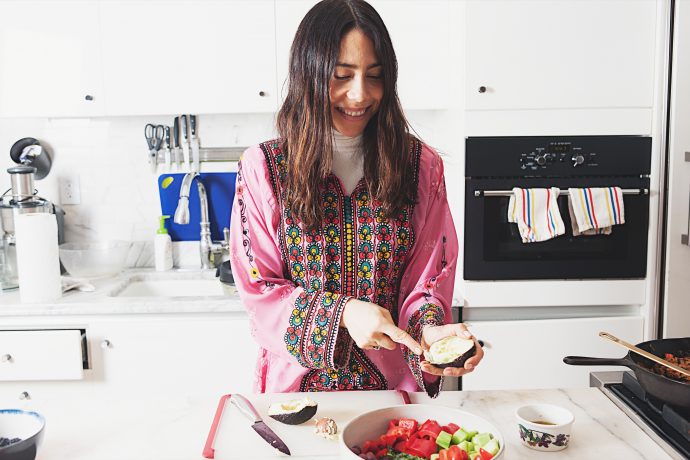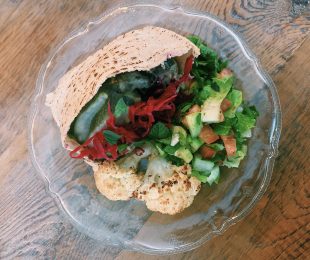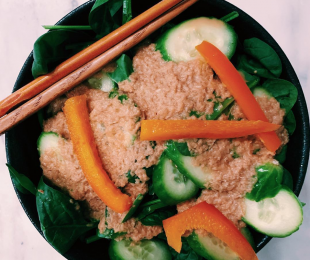FOOD-COMBINING. WHAT IS IT? DOES IT IMPROVE WEIGHT-LOSS? CAN I EAT CARBS? DO I NEED TO BE VEGAN? These are the most common questions I hear when I tell people about the way I eat. With vegan-ism, paleo-ism, and every -ism under the book running rampant in the health community, food-combining has remained somewhat of the redheaded stepchild (apologies to redheads) of the bunch. Yet, in my experience, it’s the most effective. I’ve eaten this way for years ever since I came across Natalia Rose’s book The Raw Food Detox Diet. This led me to meeting my personal wellness guru, Gil Jacobs, a colonic therapist and expert on all-things detox. Since re-structuring the way I eat, I’ve experienced stable weight loss, better skin, more energy and just an overall better well-being. The best part? I have not had to limit my portion size or calorie count. I’ve been able to enjoy a wide range of cuisines and foods while consistently detoxing a as long as I follow a few simple guidelines So how does it work? Read on.
Photo by Kerri Brewer
CHOOSE A PROTEIN OR STARCH FOR EACH MEAL, BUT NOT BOTH
First things first. The concept of food combining is based on the premise that fruits, proteins and starches digest at different times. Improper food combining can cause gas, indigestion, bloating , weight gain and eventually speed the process of aging. If you eat a starch meal, you must wait at least three hours after having a protein meal. That means, yes you can have carbs (sprouted or fermented are best but white basmati rice or jasmine rice is not nearly as offensive as we’re led to believe–just as long as you pair it with vegetables and not a protein like salmon. (Unfortunately, that means bidding those spicy tuna rolls adieu.) One of my favorite ways to order at a restaurant is a big salad (double order at times) with lemon and olive oil, all the veggie sides as a main and one grain, whether it’s gluten-free pasta, quinoa or a side of rice. If you’re a carnivore, you can keep your grass-fed steaks, just pair them with non-starchy vegetables like spinach or broccoli rabe and nix the potato. They mean it when they call meat and potato meals “stick-to-your-ribs meals.” So, in order to aid digestion and expedite the process of food leaving the body, you should never mix food groups, which brings me to the next principle.
DETOX IS NOT WHAT GOES IN, IT’S WHAT GOES OUT.
One of the biggest misconceptions in our society, especially now is that juicing is inherently detoxifyng. It’s not. Detoxing mean matter coming out of our body. The Cinnamon Toast Crunch, the Jaegermeister shots, the McDonald’s, the steak frites. Those remnants have remained in our body, embedded in our cells. Juice does not inherently cure us of years of vice. It simply acts as Windex to ease the removal of waste. We need to scrub our bodies of toxins through bowel movements, sweating, circulation and yes, colonics. (More on that, here.)
ON FRUIT: “EAT IT ALONE OR LEAVE IT ALONE”
Fruit is one of the cleanest, purest foods you can eat. That said, if you’ve ever experienced any issues with yeast or candida, it’s smart to stay away from sweet fruits, which can foster more yeast in the system. Instead, stick with low-sugar green juices of kale, celery, cucumber, fennel, romaine and lemon and ginger. If you feel you thrive on fruits, begin your day with a heaping plate of your favorite fruits (ideally seasonal.) They will give your body an alkaline boost to ensure better digestion and enzymes for the remaining of the day. This means no more pairing bananas and berries over cereal or oatmeal and ideally no fruits in your almond milk smoothie, unless they are acidic (like berries, apples and citrus, which can combine neutrally.)
STRUCTURE YOUR MEALS AND YOUR DAY “LIGHT TO HEAVY”
Within the principles of food combining, we digest light foods the fastest and heavier foods slowly. So, in order to aid digestion and prevent gas, bloating, etc. We structure our meals light to heavy. That means a salad before every cooked meal and never fruit at the end of a meal, since it’s considered light. If we have a fruit salad for dessert, thinking we’re being “healthy”, it will hit that heavier meal and begin to ferment and “rot” that cooked food. The result? Bloating, acid reflux, indigestion and eventually weight gain. In the mornings, we should eat our lightest, so a fresh green juice or fruit salad is the ideal breakfast.
NEUTRAL “FREEBIES” TO SPICE UP YOUR MEALS
The following things below are considered “neutral” and pair with both a protein or a starch. I especially love to add them in salads to make a plate of raw veggies sing without dousing it in a creamy dressing or tons of oil.
–Coarse Sea Salt for crunchy texture
–Cayenne Pepper for a spicy kick
–Valentina hot sauce, (goes with everything, in my opinion)
–Capers
–Castelvetrano or Kalamata Olives
–Hearts of Palm
–Toasted Sesame Oil
–Gluten-Free Tamari Sauce
–Apple Cider Vinegar
–Maille Dijon Mustard
–Raw Vegan Kimchi
–Raw Vegan Sauerkraut
Things To Remember About Food-Combining
- Eat fruits and fresh juices alone on an empty stomach
- Never mix starches or proteins
- Don’t overdo the oils or cooked fats
- Always have a raw salad before every cooked meal
- If you’re going to “cheat,” do it at the end of the day
- Incorporate probiotics, digestive enzymes and warm lemon water to aid digestion or as ammo after a splurge
- Food-combining alone isn’t the answer. Partner this diet with plenty of sweating, circulation, sun and movement
General Food Combining Chart
Neutral (Can Pair With Anything): All leafy greens, celery, cucumber, garlic, onions, broccoli, carrots, parsnip, spaghetti squash, tomatoes, eggplant, cauliflower, beets, zucchini, yellow squash, peppers, oils, grass-fed butter
Starches (Can Pair with Neutral Veggies and Other Starches, Not Proteins or Nuts): Sweet potatoes, yams, white potatoes, avocado, butternut squash, kabocha squash, quinoa, rice, wheat, pasta, kasha, amaranth, millet
Proteins (Can Pair with Neutral Veggies and Other Proteins, Not Starches or Nuts): All animal meats, cheese, fish
Both (Not ideal food but okay to combine with both): All legumes, chickpeas, lentils, beans, sweet peas
Nuts/Dried Fruit (Only combine with each other or neutral vegetables) : Raw almonds, cashews, peanuts, sunflower seeds, raisins, currants, dried apricots, dried mango, etc.
Please note: I am not a certified nutritionist and make no claims to the contrary. Each individual’s dietary needs and restrictions are unique to the individual. Information is provided based on my experience alone. You are ultimately responsible for all decisions pertaining to your health.





0 Comments